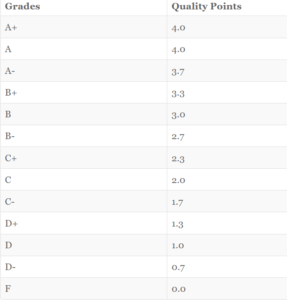By Derek DeBurger
We all have our ideas of perfection.
For some, it’s the look on your friend’s face after you give them the most magical gift.
For others, it’s a weighted blanket with a plate of Ritz crackers and Kraft singles, while you watch your favorite episode of Parks and Recreation.
For a transcript, perfection looks like a 4.0.
However, all 4.0s are not created equal.
The bane of a student’s existence: the plus/minus system
Every University of Louisville student is familiar with the plus/minus system; it’s the bane of many students’ existence.Why would an institution of higher education implement a system that damages one’s resume before one enters the workforce?
The reason is to combat what’s known as grade inflation.
Grade inflation is the steady incline in the average GPA of students at four-year colleges and universities since the 70s and 80s. This consequently bestows grades to students who don’t deserve them.
Let’s run through a scenario:
Students A and B are taking the same course but at different universities. Student A goes to a school that uses plus/minus, but Student B does not. Student A gets a 93% in the course, and Student B gets a 92%. Student A did better in the course but needed a 94% to receive an A. So, Student A got a 3.7 while Student B got a 4.0. Although Student A did marginally better in the course, Student A looks like an inferior student when compared to Student B.
Let’s do another scenario with the same students as before but this time Student B goes to one of the Ivy Leagues—we’ll call it the Oak League.
This time, Student A gets a 100% in the course and Student B gets a 90%—a big difference in comprehension and understanding of the material. However, because the Oak League doesn’t do plus/minus and the school Student A goes to counts an “A” and an “A+” as the same on a transcript, both students get 4.0s on their GPA. Despite Student B clearly displaying a more difficult time grasping the concepts of the course, because Student B goes to the highly esteemed Oak League University, Student B’s 4.0 looks better on a resume than Student A’s 4.0.
If all the plus/minus system does is make almost everyone involved come out at the other side feeling inadequate, why not just get rid of it? “It’s always been this way” is simply a bad response. You don’t stick with something that doesn’t work just because you’re scared of change and conflict.
A change in the plus/minus system at the University of Louisville (U of L) is necessary, considering the negatives. If not the abolition of the plus/minus system, there needs to be a modification of it.
A simple change: rewarding those who do better
Currently, the plus/minus system for the U of L is as follows:

From the University of Louisville
What is the point of an “A+” if it’s just worth an “A”? There is no point, except for the system created on the West Coast by Stanford University.
Stanford University is a private university, often referred to as the “Ivy of the West,” and is affiliated with U of L in Atlantic Coast Conference athletics. Stanford rewards their hardworking students with a 4.3 GPA upon earning an “A+.”
Blasphemy! How dare an institution defile the prestige of the hallowed 4.0! You can’t simply turn the dial up to 11, it only goes to 10!
References to ‘80s movies aside, what’s the problem with rewarding someone for doing better? There is no problem. It does not make sense, and it is not fair, to not reward people for exceeding expectations when they are freely and readily punished for not meeting those expectations.
In its current state, it’s a system that causes more problems than were intended to fix. We can fix the problems, we just have to convince the powers-that-be that the system is what needs fixing.





